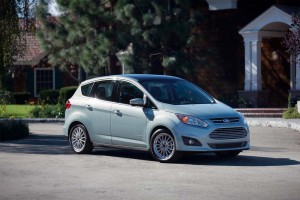
Ford is about to re-state the fuel economy rating on C-Max Hybrid - and the EPA may follow with changes in its own testing and labeling procedures.
Ford Motor Co. will announce significant revisions to the fuel economy rating of its C-Max Hybrid later today, an estimated 10% reduction reflecting the gap between what has been posted on the “people-mover’s” window sticker and what most buyers are getting in real-world use.
Ford has been taking some hits for the fuel economy ratings of several vehicles, especially hybrid models, and now faces several lawsuits from disgruntled owners. But it is far from alone. A number of makers have been criticized – and occasionally sued – for what critics have called unrealistic and overly optimistic ratings.
Manufacturers like Ford, in turn, have pointed the finger back at the Environmental Protection Administration, the federal agency overseeing mileage testing and approved mpg ratings. The EPA is expected to follow Ford’s lead by announcing on Friday that it will revise the way it determines fuel economy for vehicles – particularly hybrids, which frequently deliver lower real-world numbers than motorists were led to expect.
The EPA said last December it was looking into the 47 mpg ratings for Ford’s C-Max and Fusion hybrid models. The maker is expected to reduce the combined city/highway number to 43 mpg. In fact, the law permits a manufacturer to post numbers lower than the EPA test results generate if it expects to see lower fuel economy on the street.
Ford last month announced plans to update the software of about 77,000 of its various hybrid models – also including the new Lincoln MKZ model – to improve real-world fuel efficiency. The programming changes take steps such as increasing to 85 mph the speed at which the hybrids can operate in electric-only mode, up from the current 62. And the active-grille shutters that are used to improve aerodynamics will now stay closed more often while driving.
Because of the way fuel economy is calculated, there is always a degree of uncertainty about what a vehicle will get when driven by the typical consumer. And that “variability” increases by the virtue of basic math and the higher the mileage rating of a vehicle. On a 25-mpg vehicle, a 10% variability would mean 2.5 mpg while on a 47-mpg model that would jump to nearly 5 miles per gallon.
“The sensitivity is higher for vehicles rated to deliver especially high mileage,” notably hybrids, explains Greg Schroeder, a senior research engineer at the Center for Automotive Research, or CAR, in Ann Arbor, Mich.
(Click Here to read about Ford’s fix for improving hybrid mileage.)
That shortfall with Ford hybrids has nonetheless prompted several lawsuits, including one filed in May by Massachusetts Ford C-Max owner, Marianne Cibeu, who alleges she was getting only 32 mpg. “Plaintiffs purchased a Fusion Hybrid or C-Max Hybrid, only to be stuck with under-performing, less valuable vehicles that inflict higher fuel costs on their owners,” the lawsuit alleged.
Meanwhile, two California law firms have consolidated their own legal actions accusing Ford of making “false and misleading” mileage claims.
(Ford wants a new way to measure mileage. For more, Click Here.)
Ford is by no means alone. Early last year, Honda landed in hot water when a small claims judge in Southern California sided with a frustrated owner who wanted the Japanese maker to reimburse her for added fuel costs on her Civic Hybrid and the likely lower trade-in value. She initially won her case, though Honda eventually got the small claims court verdict reversed, but it went on to settle a separate class action suit over lower-than-expected mileage.
The EPA has repeatedly tried to adjust its testing procedures to cope with the mileage problem, most recently in 2008. The agency will announce specific plans on Friday to try to make its test results better reflect what consumers should expect.

It’s cheaper to give in than fight a lawsuit by the EPA that an auto maker can’t win because the EPA test cycle does not represent the results a “typical” driver might get, thus punish the auto maker for the EPA’s problems.